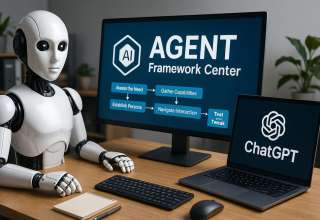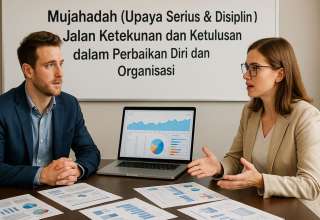*) Gambar sebagai ilustrasi
The SKILLS Framework: A Strategic Model for Managing Human Potential
Developed by Mohamad Haitan Rachman, Negeri Framework
Introduction
The twenty-first century is defined by speed, disruption, and transformation. Emerging technologies, shifting global markets, and complex societal challenges are forcing individuals, organizations, and governments to rethink how they prepare for the future. At the heart of this shift is one central element: skills. Unlike static qualifications or rigid job descriptions, skills are dynamic, transferable, and measurable. They represent the true currency of modern economies and the foundation of human adaptability.
This is where the SKILLS Framework, developed by Mohamad Haitan Rachman under the Negeri Framework ecosystem, provides a groundbreaking model. It offers a structured, practical, and future-oriented approach to managing, developing, and sustaining skills at all levels—personal, organizational, and national. The framework consists of six interconnected elements: Scan, Know the Gaps, Improve, Leverage, Link, and Sustain.
This essay explores the philosophy, structure, applications, and significance of the SKILLS Framework, situating it within the context of global changes and the broader Negeri Framework ecosystem.
1 – Why Skills Matter Today
The Shift from Jobs to Skills
For much of the twentieth century, careers were defined by job titles, degrees, and hierarchical promotions. A person’s identity was tied to their role—engineer, teacher, banker, or doctor. However, the twenty-first century workplace no longer operates in this way. Jobs are being automated, tasks are being unbundled, and organizations increasingly prioritize skills over titles.
Companies such as IBM, Google, and LinkedIn advocate for “skills-first hiring,” where candidates are evaluated based on what they can do rather than which diplomas they hold. The World Economic Forum estimates that by 2030, over one billion people worldwide will need to be reskilled to remain employable. This massive shift underlines why skills—not just knowledge or competencies—are now the building blocks of employability, adaptability, and innovation.
Skills as Part of Competency
A competency is a broad cluster that combines knowledge, skills, abilities, and behaviors. Skills form the practical and demonstrable part of competency—the part that can be observed, tested, and applied. While competencies remain useful for long-term strategy, skills are more operational and immediate. This is why organizations talk about “skills management” rather than “competency management.” Skills are easier to measure, update, and align with current needs.
2 – The SKILLS Framework
The SKILLS Framework is designed as a six-step cycle that ensures individuals and organizations can continuously identify, develop, and deploy skills effectively.
1. Scan
The first step is to scan the current skills landscape. For organizations, this means building a skills inventory or matrix that maps employees against specific skill sets and proficiency levels. For individuals, it involves honest self-reflection and documenting one’s strengths.
Techniques include surveys, digital tools, AI-powered HR platforms, and peer assessments. Without an accurate scan, organizations risk making decisions in the dark.
2. Know the Gaps
Once the skills inventory is clear, the next step is identifying gaps between current skills and future requirements. This process is both diagnostic and predictive: it highlights deficiencies in today’s workforce and anticipates skills that will be critical tomorrow.
For example, a fintech startup may discover a shortage of data ethics expertise. A university may realize its graduates lack entrepreneurial skills. Governments may recognize that citizens need stronger digital literacy. Gap analysis allows leaders to act strategically.
3. Improve
Skills gaps cannot be ignored—they must be closed through targeted improvement. The Improve stage focuses on learning, development, and growth. Training can be formal (courses, certifications), informal (mentoring, peer exchange), digital (MOOCs, microlearning), or experiential (job rotation, projects).
Importantly, improvement covers both hard skills (technical knowledge, tools, coding) and soft skills (communication, leadership, creativity). In today’s workplace, adaptability, problem-solving, and resilience are just as critical as technical expertise.
4. Leverage
Skills only gain value when they are applied. The Leverage phase ensures that individuals with the right skills are assigned to the right roles, teams, or innovation projects. This prevents underutilization and maximizes organizational performance.
In practice, leverage means workforce planning, project staffing, and internal mobility platforms that match employees to opportunities. For individuals, leverage involves actively seeking chances to use skills in real-world contexts, thereby reinforcing learning and building visibility.
5. Link
Skills should not exist in isolation. They must be linked to broader outcomes—performance, strategy, and growth. This phase ensures alignment between skills and:
- Individual careers: linking skills to promotions, career paths, and employability.
- Organizational goals: linking skills to KPIs, Balanced Scorecards, and innovation targets.
- Societal outcomes: linking skills to national competitiveness, sustainable development goals, and entrepreneurship.
By linking skills to outcomes, organizations demonstrate the tangible value of skill development.
6. Sustain
The final step is sustainability. Skills depreciate quickly in fast-changing industries. What is relevant today may be obsolete tomorrow. Therefore, the Sustain phase emphasizes lifelong learning, continuous reskilling, and embedding learning into the culture of organizations and societies.
For individuals, this means cultivating curiosity and adaptability. For organizations, it requires systems that make learning part of everyday work. For nations, it means policies that normalize reskilling and ensure education systems evolve continuously.
3 – The Philosophy Behind SKILLS
The SKILLS Framework rests on three key philosophical pillars:
- Practicality: Skills are tangible, measurable, and applicable.
- Continuity: Skills management is not a one-time project but an ongoing cycle.
- Integration: Skills connect personal growth, organizational performance, and national development.
These pillars reflect the broader philosophy of the Negeri Framework: building models that are strategic, structured, and actionable across multiple contexts.
4 – Integration with Negeri Framework Ecosystem
The SKILLS Framework does not stand alone. It is designed to complement and integrate with other frameworks developed by Mohamad Haitan Rachman.
- TALENT Framework: Focuses on tracing, aligning, and nurturing human potential. SKILLS provides the operational tools to implement TALENT.
- PERFORM Framework: Centers on executing and refining excellence. SKILLS supplies the human capabilities required for sustained performance.
- KE3 Framework: Manages knowledge exploration, enrichment, and exploitation. SKILLS translates knowledge into practical abilities.
- SUCCESS Framework: Guides strategic clarity and innovation. SKILLS ensures that strategies are backed by actual capabilities.
- CYCLE and PRODUCT Frameworks: Manage innovation lifecycles. SKILLS ensures each phase is staffed with the right expertise.
Together, these frameworks create a holistic ecosystem that bridges knowledge, skills, performance, and strategy.
5 – Applications of the SKILLS Framework
1. Individual Level
- Career Planning: Individuals can map their current skills, identify gaps, and plan learning pathways.
- Employability: By focusing on measurable skills, individuals improve their chances in the labor market.
- Personal Growth: Sustaining learning ensures long-term adaptability.
2. Organizational Level
- Human Resource Management: HR teams can build skill matrices to plan recruitment, training, and promotions.
- Learning and Development: Training becomes targeted and efficient, closing specific gaps.
- Project Management: Teams can be staffed with members whose skills align with project needs.
- Innovation: Cross-functional skills deployment sparks creativity and problem-solving.
3. Educational Level
- Curriculum Development: Universities can design programs aligned with industry-relevant skills.
- Teaching Factories and Incubators: SKILLS provides a model for integrating classroom learning with practical application.
- Graduate Employability: Students leave education with clear skills portfolios.
4. National and Societal Level
- Skills-Based Economy: Nations can adopt SKILLS as a framework for workforce development.
- TVET and Lifelong Learning: Vocational and adult education programs can be aligned with real market needs.
- Policy Design: Governments can link skills development with SDGs, digital transformation, and economic competitiveness.
6 – Benefits
The SKILLS Framework offers multiple benefits:
- Clarity: Provides a simple, memorable roadmap.
- Actionability: Translates abstract strategies into measurable steps.
- Flexibility: Applicable to individuals, organizations, and nations.
- Integration: Fits within broader frameworks and ecosystems.
- Future-Readiness: Prepares people for continuous change.
7 – Challenges and Responses
- Resistance to Change: Employees may hesitate to reskill.
- Response: Show the career benefits of skills growth.
- Rapid Obsolescence: Skills become outdated quickly.
- Response: Emphasize the Sustain phase with lifelong learning.
- Measurement Difficulties: Not all skills are easily quantified.
- Response: Use a mix of qualitative and quantitative assessment.
- Balancing Soft and Hard Skills: Organizations may overemphasize technical skills.
- Response: Ensure that communication, adaptability, and leadership remain part of the framework.
8 – Case Example
Consider a digital marketing company facing disruption from AI tools. By applying the SKILLS Framework:
- Scan: The company identifies employees’ current digital marketing and analytics skills.
- Know the Gaps: It discovers a shortage in AI-driven content generation.
- Improve: Employees are trained in prompt engineering and data visualization.
- Leverage: Those who complete training are deployed to AI-integrated campaigns.
- Link: Skills are tied to KPIs like campaign reach and ROI.
- Sustain: Continuous workshops ensure employees stay current with evolving AI tools.
This example demonstrates how SKILLS bridges immediate needs with long-term sustainability.
Conclusion
The SKILLS Framework developed by Mohamad Haitan Rachman under the Negeri Framework ecosystem is more than a model of training—it is a strategic philosophy for managing human potential. By guiding individuals, organizations, and nations through the steps of Scan, Know the Gaps, Improve, Leverage, Link, and Sustain, it ensures that skills become the living currency of progress.
In a world where jobs are changing but skills endure, the SKILLS Framework provides clarity, structure, and sustainability. It aligns with other Negeri Frameworks—such as TALENT, PERFORM, SUCCESS, and KE3—to build a comprehensive ecosystem for innovation, leadership, and transformation.
The message is clear: the future belongs not to those who cling to old job descriptions, but to those who continuously scan, improve, leverage, and sustain their skills. With the SKILLS Framework, individuals and societies can thrive in uncertainty and create pathways toward enduring excellence.

